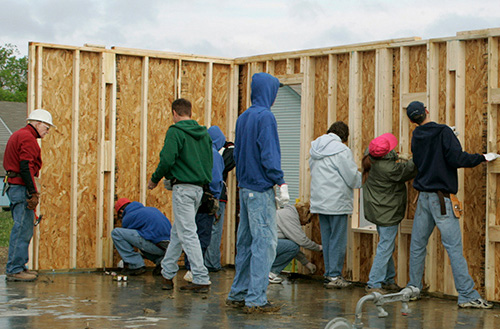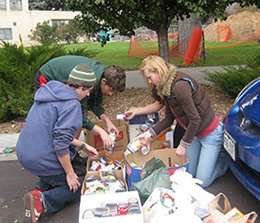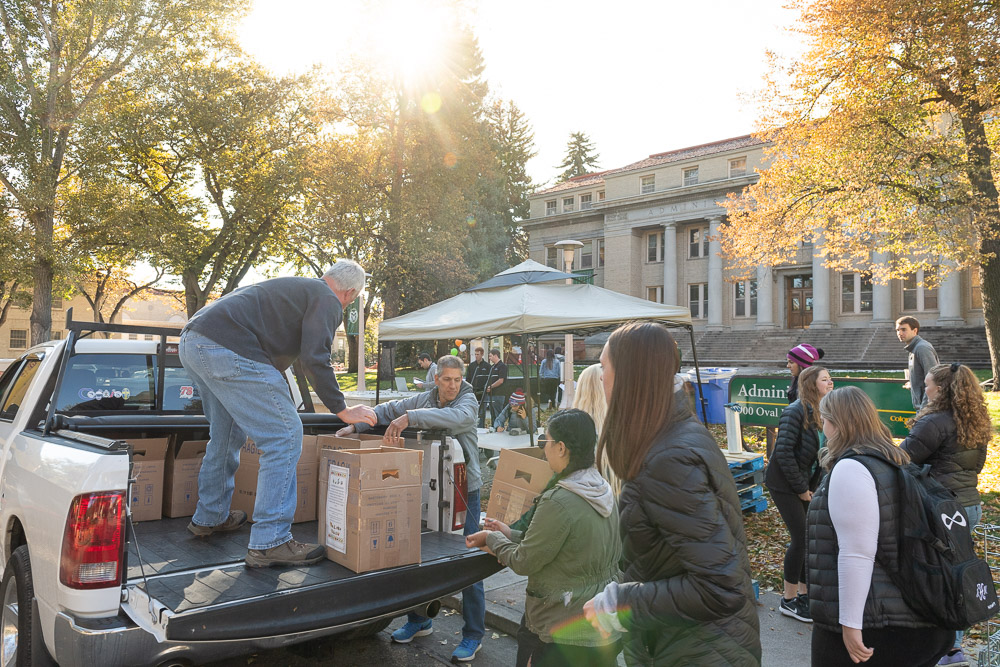Instructional Innovation and Engagement
Service Learning
"Students are unlikely to be effective citizens without the ability to understand complex social problems, apply what they learn, and have the critical thinking ability to make adequate judgments about the information they receive."
Janet Eyler and Dwight Giles, from Where is the Learning in Service-Learning? (1999)
Overview
Service-learning is a pedagogical practice that integrates service and academic learning to promote increased understanding of course content while helping students develop knowledge, skills, and cognitive capacities to deal effectively with the complex social issues and problems. At the same time, it addresses unmet community needs. It is an approach that emphasizes reflection and experiential, field-based learning as a way to engage the learner personally with the curriculum.

As Pedagogy
Service learning emphasizes meaningful student learning through applied, active learning that draws on multiple knowledge sources (academic, student knowledge and experience, and community knowledge) and provides students with ample opportunities for ethical and critical reflection and practice.
By confronting issues and problems in complex natural contexts, students in service-learning courses develop a deeper understanding of subject matter, a practical knowledge of community decision making processes, and strategies for transferring knowledge and problem solving skills to new situations.
Effective service-learning classes are those that use service and civic engagement to integrate and enhance academic learning, not to take the place of it. Service-learning courses, when thoughtfully designed, combine content-driven, outcomes-based commitments with ample opportunity for learning and knowledge to grow from students’ service experiences.
Key Characteristics Of Effective Service-Learning Courses
- Service experience is clearly and explicitly integrated into the academic curriculum and linked to learning goals.
- Students participate in structured reflection on their service experience (before, during, and after) in light of particular learning objectives.
- Service-learning activities are designed in collaboration with community representatives and serve genuine community needs.
The best service-learning activities are those that equally emphasize student learning and addressing community needs, promoting a “partnership of mutual benefit” between students, faculty, and community collaborators.
“Tomorrow’s whole person must have, in brief, a well-educated solidarity. When the heart is touched by direct experience, the mind may be challenged to change. Personal involvement with innocent suffering is the catalyst for solidarity, which then gives rise to intellectual inquiry and moral reflection.”
— Peter-Hans Kolvenbach, S.J.
Developing Leadership Tools
Service-learning projects help students develop the tools that will help them become effective and knowledgeable leaders in the diverse community where they will work and live.
Benefits
- Develops research, critical thinking, and interpersonal skills.
- Provides understanding of how to access the larger community as a resource for skill-building and learning.
- Helps students identify multiple stakeholders and their interests and to see multiple viewpoints.
- Allows interaction with diverse populations.
- Provides career experience.
- Engages students in community problem solving at local, national, and international levels.
- Allows for commitment and service to the community.
Becoming Part of the Solution
Working with community organizations, students engage in real-world issues and social problems, becoming part of the solution.
Developing relationships with community members and a deeper understanding of the root causes and broader social issues that contribute to community problems, students develop an understanding of specific issues, assets, and the processes for making change happen.
In all of these ways, service learning helps students learn, understand and engage with others, while developing the necessary skills and attitudes to become multicultural community builders in a rapidly changing, diverse world.
At Least 80% of CSU Students agree that Service-Learning Class(es):
- deepened their interest in the subject matter.
- enhanced their understanding of course content.
- enabled them to apply skills and concepts learned in class.
- influenced their values, beliefs and attitudes.
- increased their self-esteem.
- were beneficial to the community.
 Direct Service
Direct Service
Direct service activities require personal contact with people in need. These types of activities are generally the most rewarding as students, while in the process of helping others, receive immediate positive feedback.
Examples include students’ working with senior citizens or reading to small children in intergenerational projects.
Direct service teaches students to take responsibility for their actions. They also learn that they make a difference by making a difference.
Indirect Service
Indirect experiences are commonly implemented in schools as they are easy to organize, involving students’ working behind the scenes.
Such activities are often centered in channeling resources to a problem rather than working directly with individuals needing a particular service./p>
Examples include collecting food or toys for disadvantaged families, participating in community park landscaping, and other such such social and environmental projects.
These activities are generally done by a group that won’t come in contact with the people they serve. Nevertheless, teamwork and organizational skills are learned and practiced.
Community-Based Research
Community-based Research (CBR) is defined as a partnership of students, faculty, and community partners who collaboratively engage in research with the purpose of solving a pressing community problem or effecting social change.
Typical CRB projects include faculty, students and community partners working together to focus local attention on pressing community needs.
They might also include researching and evaluating new programs, evaluating and assessing existing programs, or creating qualitative and quantitative research tools.
Advocacy
Advocacy requires students to lend their voices and talents to the effort of eliminating the causes of a specific problem and to making the public aware of the problem.
Activities may include making presentations to the community about a particular issue or distributing literature related to it throughout specifically affected neighborhoods.
Students learn to present their concerns clearly, to be concise in presenting their ideas, and to suggest feasible solutions.
Check Out These Links:
- United Way
- AmeriCorps
- Student Leadership, involvement & Community Engagement (SLiCE)
- Key Service Community
Participate in the CURC Poster Showcase
The annual Spring Semester Celebrate Undergraduate Research and Creativity Poster Showcases is a high-visibility opportunity for CSU students and faculty, across the disciplines, to present their service-learning and community-based research projects as well as the teaching accomplishments of the faculty.
Check out CURC
Enroll in a “For Credit” Service-Learning Course
View all Service-Learning Courses
About the Award
Each year the TILT Service-Learning Program presents one CSU student or student group with a $200 award and plaque.
This award is in recognition of a remarkable social or environmental contributions achieved through an academic service-learning course, a supervised internship or professional project, or community-engaged research.

